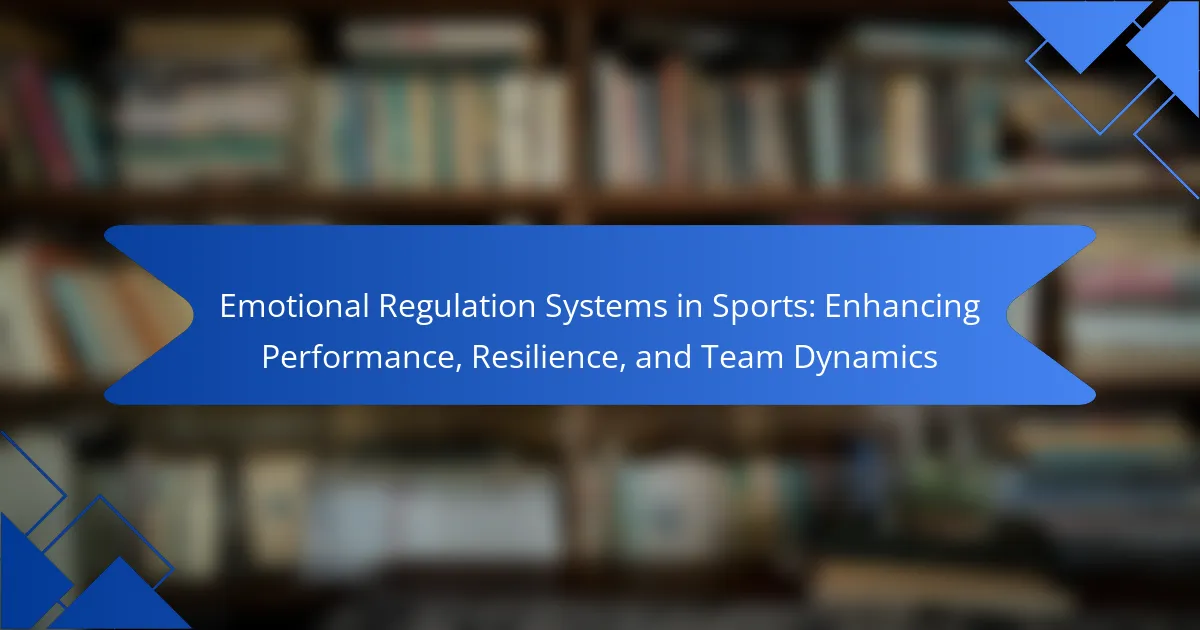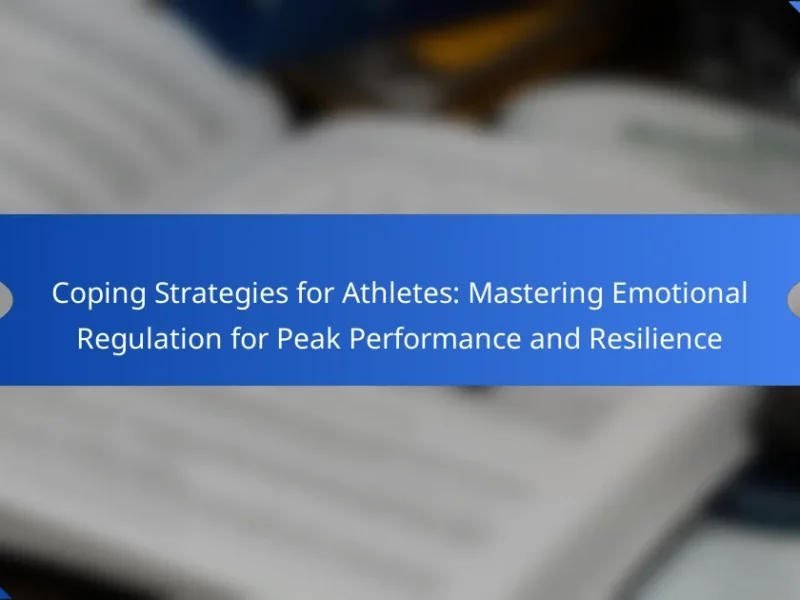Emotional regulation systems in sports enhance performance, resilience, and team dynamics. Key components include awareness of emotional triggers, effective control strategies, and robust social support. These systems vary by sport, focusing on collective emotional management in team sports and personal emotional control in individual sports. Implementing best practices like mindfulness training and open communication fosters a high-performing team environment.
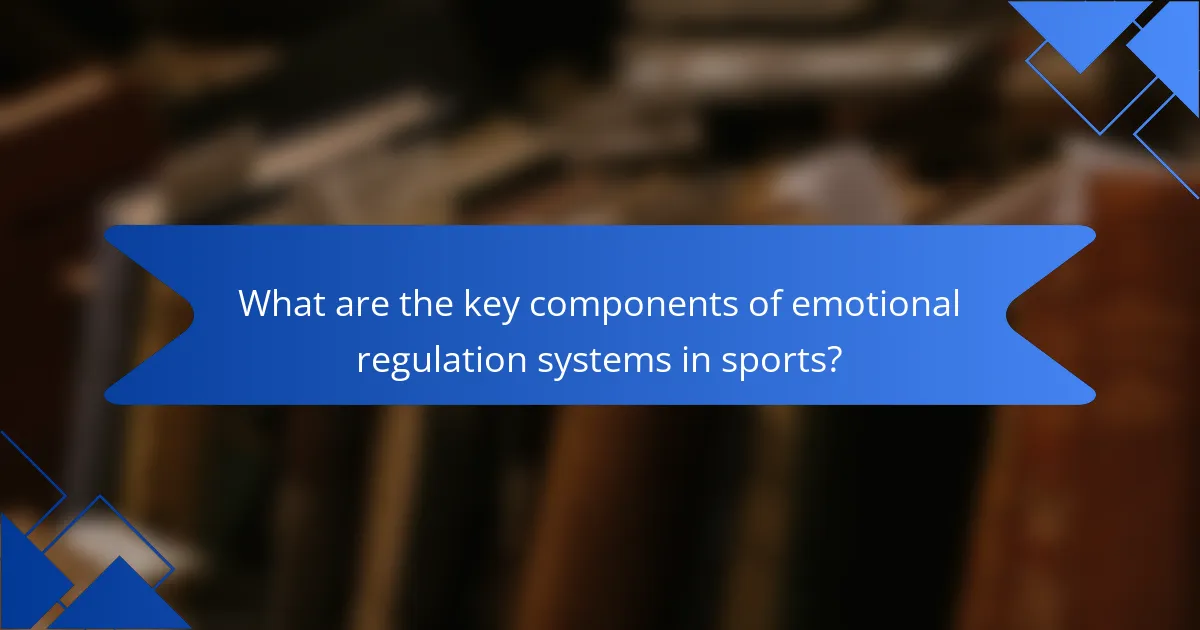
What are the key components of emotional regulation systems in sports?
Emotional regulation systems in sports consist of awareness, control strategies, and social support. These components enhance performance by enabling athletes to manage stress and maintain focus. Awareness involves recognizing emotional triggers, while control strategies include techniques like mindfulness and cognitive restructuring. Social support provides a network for sharing experiences and coping mechanisms. Together, these elements foster resilience and improve team dynamics, ultimately leading to better outcomes in competitive environments.
How do emotional regulation systems influence athlete performance?
Emotional regulation systems significantly enhance athlete performance by improving focus, resilience, and team dynamics. These systems enable athletes to manage stress and anxiety, leading to better decision-making and execution during competitions. For example, studies show that athletes with strong emotional regulation skills experience fewer performance dips under pressure. This ability to maintain emotional balance fosters a positive team environment, enhancing collaboration and communication among teammates. In turn, this collective emotional resilience can lead to improved overall performance outcomes.
What role does emotional regulation play in team dynamics?
Emotional regulation is crucial for effective team dynamics as it enhances communication and collaboration. Teams with members skilled in emotional regulation demonstrate higher resilience and adaptability during challenges. This skill fosters a positive environment, reducing conflicts and improving overall performance. Research indicates that teams exhibiting strong emotional regulation can achieve better outcomes and maintain cohesion under pressure.
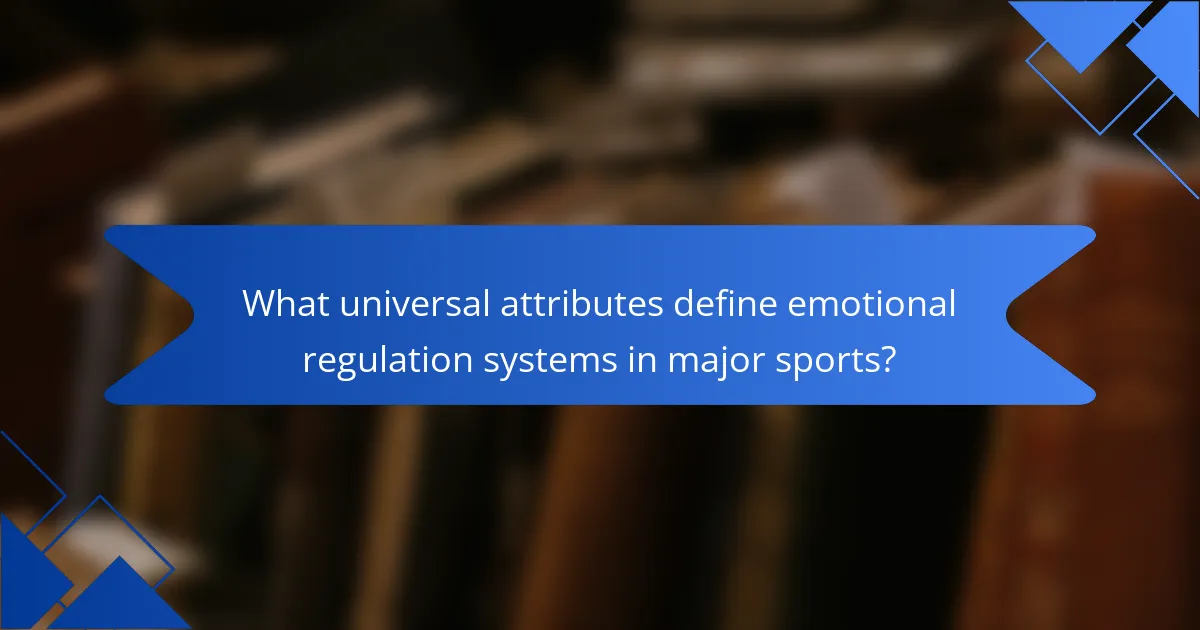
What universal attributes define emotional regulation systems in major sports?
Emotional regulation systems in major sports are defined by adaptability, awareness, and social support. These attributes enhance performance, resilience, and team dynamics. Adaptability allows athletes to adjust their emotions to changing situations, improving focus and decision-making. Awareness involves recognizing one’s emotional state, which fosters better self-control and reduces anxiety. Social support from teammates and coaches enhances emotional resilience, creating a positive environment that promotes mental well-being. Together, these attributes form a robust foundation for effective emotional regulation in sports.
How do emotional awareness and expression contribute to performance?
Emotional awareness and expression significantly enhance performance by improving focus, reducing anxiety, and fostering team cohesion. Athletes who effectively manage their emotions can respond better under pressure, leading to improved decision-making and execution of skills. This emotional regulation allows for greater resilience, enabling athletes to bounce back from setbacks and maintain motivation. Additionally, open emotional expression within teams promotes trust and collaboration, which are essential for achieving collective goals.
What techniques are commonly used for emotional regulation in sports?
Common techniques for emotional regulation in sports include cognitive restructuring, mindfulness practices, and self-talk strategies. These methods enhance athletes’ performance and resilience by helping them manage stress and maintain focus. Cognitive restructuring involves identifying and challenging negative thoughts, while mindfulness promotes awareness and acceptance of emotions. Self-talk strategies allow athletes to reinforce positive beliefs and motivations, ultimately improving team dynamics and individual outcomes.
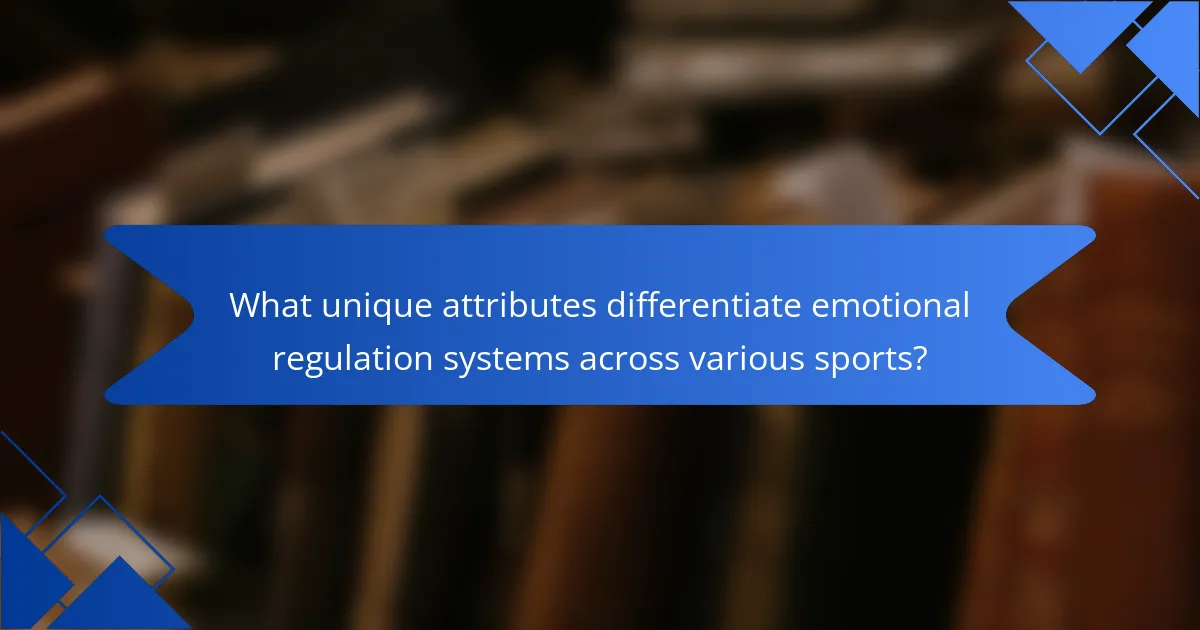
What unique attributes differentiate emotional regulation systems across various sports?
Emotional regulation systems in sports vary significantly, influenced by the unique demands of each sport. Team sports often emphasize collective emotional management, fostering resilience through shared experiences, while individual sports focus on personal emotional control to enhance performance.
For instance, in basketball, players rely on quick emotional adjustments to maintain focus during high-pressure moments. In contrast, long-distance runners may develop a unique attribute of sustained emotional endurance, allowing them to cope with prolonged stress.
Additionally, combat sports often necessitate a unique attribute of aggressive emotional regulation, where athletes must channel intense emotions into performance without succumbing to panic. These distinctions highlight how emotional regulation systems are tailored to the specific challenges and environments of different sports.
How do sports culture and environment shape emotional regulation practices?
Sports culture and environment significantly influence emotional regulation practices by fostering resilience and enhancing team dynamics. The competitive atmosphere encourages athletes to develop coping strategies, leading to improved performance. For instance, supportive team environments promote positive emotional exchanges, which enhance collective resilience. Additionally, rituals and shared experiences within sports culture serve as unique attributes that reinforce emotional stability, allowing athletes to manage stress effectively. As a result, emotional regulation becomes integral to achieving peak performance and maintaining mental well-being in competitive settings.
What are the unique emotional challenges faced by athletes in high-stakes competitions?
Athletes in high-stakes competitions face unique emotional challenges, including intense pressure, fear of failure, and performance anxiety. These factors can disrupt emotional regulation, impacting focus and resilience. High expectations from coaches and fans amplify stress, leading to burnout if not managed effectively. Developing emotional regulation systems is crucial for maintaining performance and fostering team dynamics. Techniques such as mindfulness and cognitive restructuring can enhance emotional resilience, allowing athletes to navigate these challenges successfully.

What rare attributes exist within emotional regulation systems in elite sports?
Rare attributes within emotional regulation systems in elite sports include personalized coping strategies, adaptive emotional intelligence, and proactive mental resilience training. These attributes enhance athletes’ ability to manage stress and maintain focus under pressure. Unique approaches, such as integrating mindfulness practices, can also significantly influence emotional stability and performance outcomes.
How do individual psychological profiles impact emotional regulation effectiveness?
Individual psychological profiles significantly influence the effectiveness of emotional regulation in sports. Tailoring strategies to match these profiles enhances performance and resilience. For instance, athletes with high emotional intelligence often demonstrate superior regulation skills, leading to better team dynamics. Conversely, those with lower emotional awareness may struggle, impacting their performance negatively. Understanding these psychological differences allows coaches to implement personalized approaches, fostering an environment conducive to growth and achievement.
What innovative approaches are being adopted in emotional regulation training?
Innovative approaches in emotional regulation training include mindfulness techniques, biofeedback, and cognitive-behavioral strategies. These methods enhance athletes’ ability to manage stress, improve focus, and foster resilience. Mindfulness training promotes present-moment awareness, reducing anxiety during competitions. Biofeedback uses technology to provide real-time data on physiological responses, helping athletes regulate emotions effectively. Cognitive-behavioral strategies focus on reframing negative thoughts, leading to improved emotional responses. These approaches collectively enhance performance and team dynamics in sports.
How can understanding emotional regulation enhance resilience among athletes?
Understanding emotional regulation enhances resilience among athletes by equipping them with skills to manage stress and adversity. Effective emotional regulation allows athletes to maintain focus, adapt to challenges, and recover from setbacks. Research shows that athletes with strong emotional regulation skills demonstrate improved performance under pressure, fostering a resilient mindset. This resilience contributes to better team dynamics, as athletes can support one another emotionally, leading to enhanced overall performance.
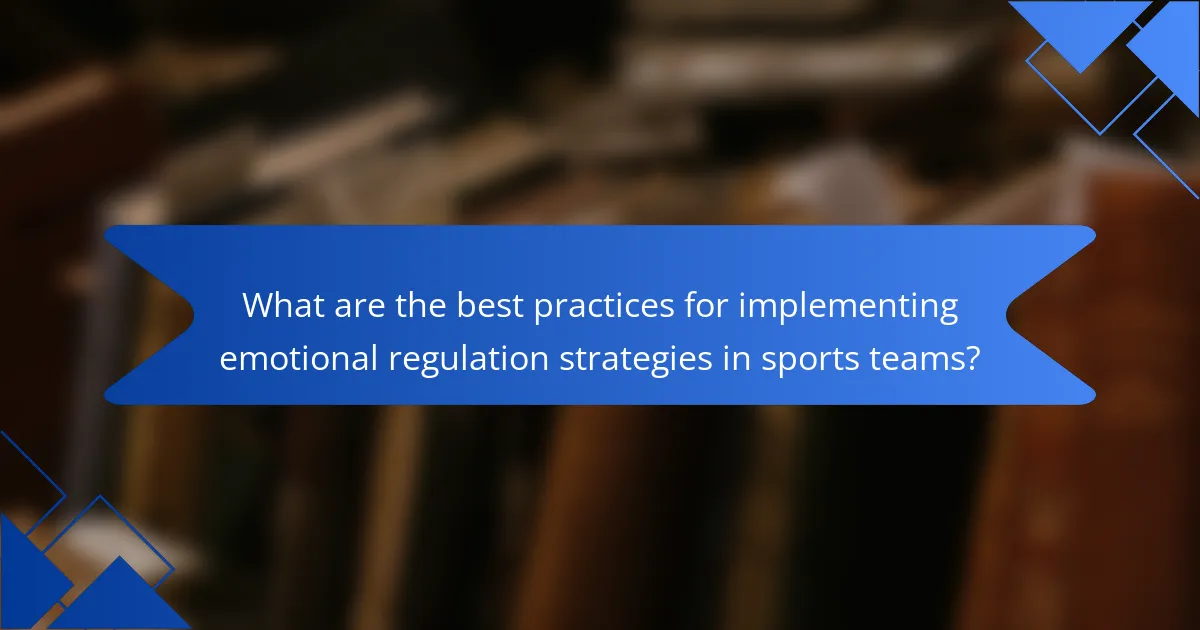
What are the best practices for implementing emotional regulation strategies in sports teams?
Implementing emotional regulation strategies in sports teams enhances performance and team dynamics. Key best practices include establishing a culture of open communication, training athletes in mindfulness techniques, and utilizing regular emotional check-ins.
Encouraging athletes to share their feelings fosters trust and collaboration. Mindfulness training, such as breathing exercises, improves focus and emotional awareness. Regular emotional check-ins help identify and address issues proactively, promoting resilience.
Additionally, integrating team-building activities can strengthen bonds and improve emotional support among teammates. These practices collectively contribute to a more cohesive and high-performing team environment.
What common mistakes should coaches avoid when addressing emotional regulation?
Coaches should avoid oversimplifying emotional regulation, neglecting individual differences, and failing to model emotional awareness. These mistakes can hinder athletes’ development and team dynamics. Recognizing that emotional regulation is complex allows for tailored approaches that enhance resilience and performance. Additionally, coaches must prioritize open communication and create a safe environment for emotional expression.
How can athletes develop personalized emotional regulation plans?
Athletes can develop personalized emotional regulation plans by assessing their emotional triggers and responses. They should identify specific situations that impact their performance and resilience. Setting clear goals for emotional management enhances focus and team dynamics. Regular practice of techniques such as mindfulness or visualization strengthens emotional control. Monitoring progress and adjusting strategies ensures the plan remains effective.
What expert insights can help optimize emotional regulation for peak performance?
Expert insights for optimizing emotional regulation focus on self-awareness, mindfulness, and communication skills. These strategies enhance athletes’ performance and resilience while improving team dynamics. Self-awareness allows athletes to recognize emotional triggers, facilitating better responses under pressure. Mindfulness practices, such as meditation, help maintain focus and reduce anxiety, leading to improved performance. Effective communication within teams fosters trust and collaboration, essential for navigating high-stress situations. Incorporating these insights can significantly elevate an athlete’s ability to perform at peak levels.
